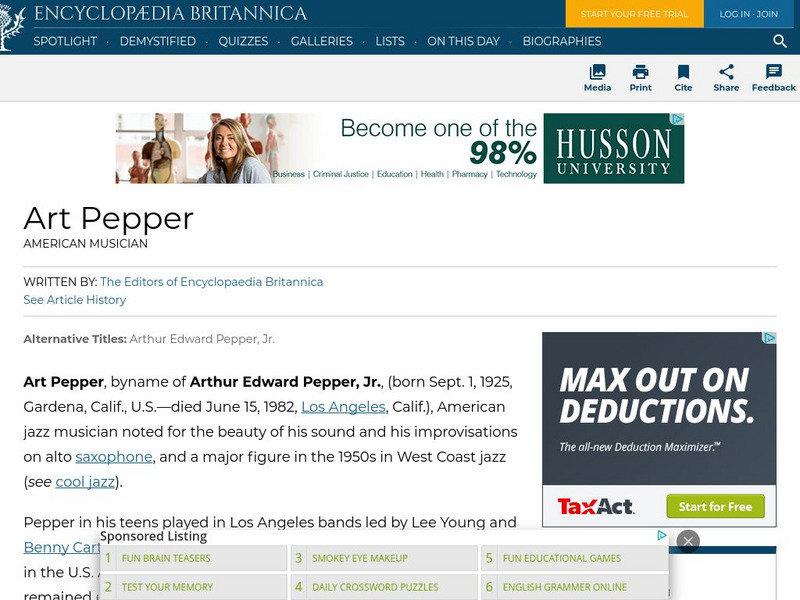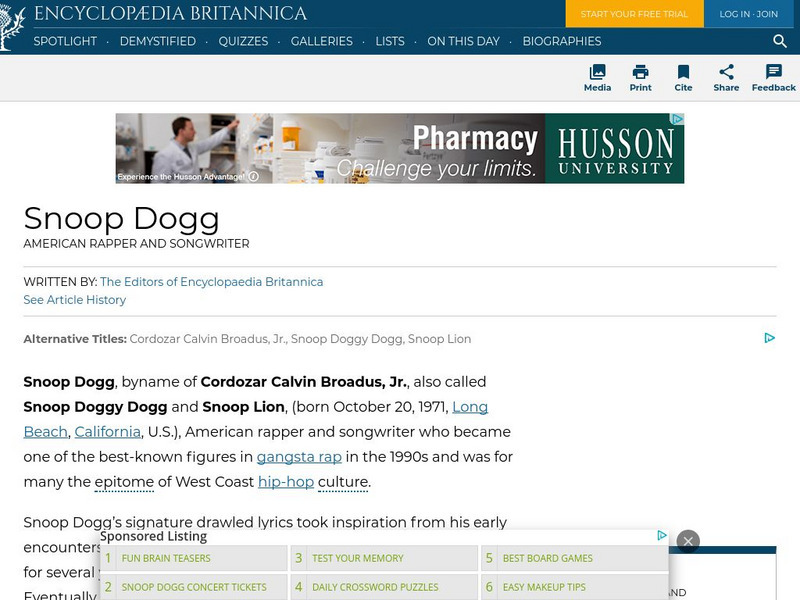Geography 4 kids
Geography4 kids.com: Types of Climates
Discover a few types of climates found on the earth like rain forests and deserts.
Other
Whitman College: Bathyal and Abyssal Echinoderms
This site provides a brief overview of echinoderms, but includes many pictures of specimens up and down the west coast.
Encyclopedia Britannica
Encyclopedia Britannica: Guide to Black History: Kenny Washington
This entry from Encyclopedia Brittanica's Guide to Black History features Kenny Washington, one of the first African American college gridiron football stars on the West Coast and one of two black players to reintegrate the National...
Smithsonian Institution
National Museum of Natural History: American Mammals: Western Red Bat
This close cousin to the eastern red bat (Lasiurus borealis) is genetically distinct. These bats are found along the west coast and the southwestern US and into Mexico where they are thought to hibernate in the winter. Learn more about...
Encyclopedia Britannica
Encyclopedia Britannica: Art Pepper
This entry from Encyclopedia Britannica features Art Pepper, an American jazz musician noted for the beauty of his sound and his improvisations on alto saxophone, and a major figure in the 1950s in West Coast jazz (see cool jazz).
Encyclopedia Britannica
Encyclopedia Britannica: Floyd Dixon
This entry from Encyclopedia Britannica features Floyd Dixon, an American rhythm and blues (R&B) musician who was one of the principal exponents of the up-tempo blues style known as West Coast jump blues.
Encyclopedia Britannica
Encyclopedia Britannica: Snoop Dogg
Learn about the life of American rapper and songwriter, Snoop Dogg, who became one of the best-known figures in gangsta rap in the 1990s and was for many the epitome of West Coast hip-hop culture.
University of Iowa
University of Iowa: Arts and Life in Africa: Sierra Leone
A record of statistics concerning modern day Sierra Leone, up to 1998. Scroll down to history section to see a brief, but informative description of pre-colonial and post-colonial history for Sierra Leone.
University of Groningen
American History: Outlines: The First Europeans
The first Europeans to arrive in North America -- at least the first for whom there is solid evidence -- were Norse, traveling west from Greenland, where Erik the Red had founded a settlement around the year 985. In 1001 his son Leif is...
University of Groningen
American History: Outlines: Colonial Indian Relations
By 1640 the British had solid colonies established along the New England coast and the Chesapeake Bay. In between were the Dutch and the tiny Swedish community. To the west were the original Americans, then called Indians.
Curated OER
Etc: Maps Etc: Heat Belts in North America, 1898
A map from 1898 showing the heat belts in North America. The map gives the boundary isotherms of the hot belt as a mean temperature of 70 degrees Fahrenheit and the cold belt as a mean temperature of 30 degrees Fahrenheit, indicating the...
Curated OER
Etc: Maps Etc: Physical Map of South America, 1898
A map from 1898 of South America showing the general physical features including mountain systems, prominent peaks and volcanoes, river and lake systems, plateaus, and coastal features. The map includes an insert of the Isthmus of...
Curated OER
Etc: Maps Etc: Africa Before the Berlin Conference, 1884
This is an interesting map of Africa showing the continent before the Berlin Conference of 1885, when the most powerful countries in Europe at the time convened to make their territorial claims on Africa and establish their colonial...
Curated OER
Educational Technology Clearinghouse: Maps Etc: Greenland, 1668
A facsimile of the Paul Egede map of Greenland (1789). Egede was the Bishop of Greenland, and this map shows colonies with Catholic and Anglican churches, and notes the locations of churches (kirker) and cathedrals. This map shows a...
Curated OER
Etc: Central America and Isthmian Routes, 1846 1860
A map of Central America during the period of westward expansion in the United States when the need to find a shorter practical shipping route from the east coast to the west coast was a principle concern. This map shows the proposed...
Curated OER
Educational Technology Clearinghouse: Maps Etc: Pre Colonial Africa, 1858
Map of Africa in 1858, prior to the extensive European colonization of the continent established at the Berlin Conference of 1885. This map shows the European possessions of the Cape Colony, Natal, and Orange River Free State, and the...
Curated OER
Etc: Maps Etc: European Possessions of Africa, 1906
A map of Africa after the Berlin Conference of 1885, which established the European colonial territory claims on the continent. This map shows the Belgian, British, French, German, Italian, Portuguese, and Spanish claims, and the Turkish...
Curated OER
Educational Technology Clearinghouse: Maps Etc: Brittany and Vendee, 1912
A Map of Brittany and Vendee along the west coast of France in 1912, showing the major cities, rivers, coastline and terrain of the region. This map shows the administrative departments at the time, including Manche, Calvados, Orne,...
Curated OER
Etc: The Wars of the Greeks and Persians, 499 448 Bc
A map of Greece, western Asia Minor, and the Agean Sea region during the Greco-Persian Wars (499-479 BC). The map shows the earlier Persian expedition into Scythia under Darius I, which included Ionian allies who sailed from the...
Curated OER
Etc: Maps Etc: Migrations of Early Native Peoples, 1889
A sketch map of North America from 1888 showing the probable lines of migration and distribution of the American Tribes, including the Esquimaux (Eskimo), West Coast Tribes, Tinne, Algonquin Tribes, and the Alleghans and Toltecans, based...
Curated OER
Educational Technology Clearinghouse: Maps Etc: South America, 1885
An orographic map of South America from 1885 showing the primary mountain systems and general elevations. The map is color-coded to show highlands in buff tint, lowlands in green, and the major mountain chains with heavy black lines. The...
Curated OER
Unesco: Canada: S Gang Gwaay
The village of Ninstints (Nans Dins) is located on a small island off the west coast of the Queen Charlotte Islands (Haida Gwaii). Remains of houses, together with carved mortuary and memorial poles, illustrate the Haida people's art and...
Curated OER
Unesco: Denmark: Ilulissat Icefjord
Located on the west coast of Greenland, 250 km north of the Arctic Circle, Greenland’s Ilulissat Icefjord (40,240 ha) is the sea mouth of Sermeq Kujalleq, one of the few glaciers through which the Greenland ice cap reaches the sea....
Curated OER
Unesco: Canada: Gros Morne National Park
Situated on the west coast of the island of Newfoundland, the park provides a rare example of the process of continental drift, where deep ocean crust and the rocks of the earth's mantle lie exposed. More recent glacial action has...









